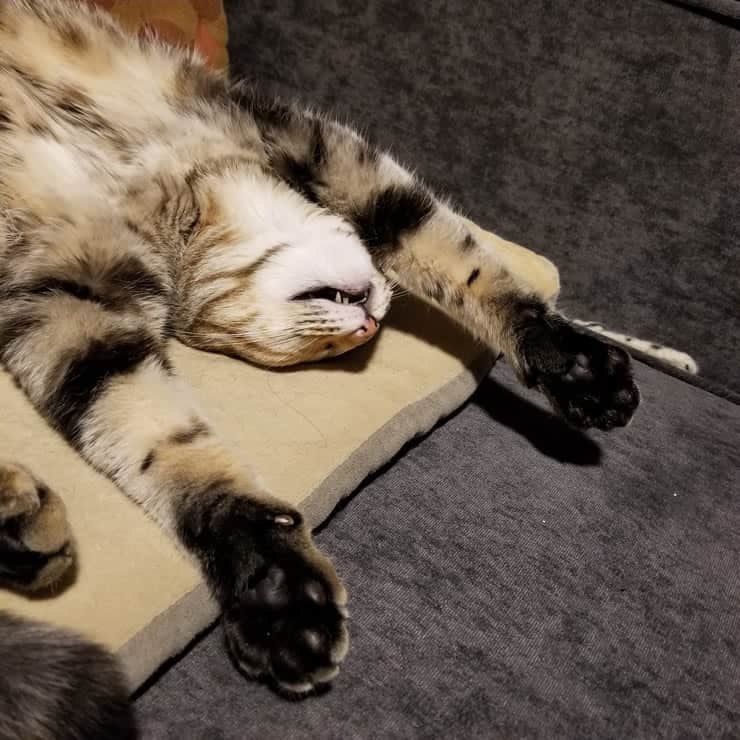
Please read this very smart blog by my very smart co-host on CAT CHAT® , Dr. Mikel Delgado. You can see why I am proud and grateful to share a platform with her, on which we advocate for cat wellness and human empathy and understanding toward felines. Dr. Mikel (pronounced Michael) is a Certified Applied Animal Behaviorist and Certified Cat Behavior Consultant, who has been working with cats for over 20 years. She has a PhD from the University of California, Berkeley, did postdoctoral research at the School of Veterinary Medicine at the University of California, Davis, and she offers cat behavior consulting through Feline Minds.
Then listen to this interview of the lead researcher on the original “cat psychopathy” study, followed by my conversation with Dr. Mikel about fundamental flaws in the study on DOG TALK (and Kitties, Too!).
A new study takes a biased look at cats
I really hemmed and hawed about whether to comment on this recent publication that has gotten a lot of press lately. But the headlines keep coming: “Is Your Cat a Psychopath? Probably, Researchers Say,” “Is Your Cat an Actual Psychopath? Take This Test and Find Out,” and so on. Now sometimes science isn’t particularly sound, and to be fair, it can be challenging to do science well. There’s always room for improvement. But sometimes a study is actually misleading or potentially even harmful, especially when it perpetuates faulty ideas about cats.
The recent publication “A domestic cat (Felis silvestris catus) model of triarchic psychopathy factors: Development and initial validation of the CAT-Tri+ questionnaire” veers into that territory. Rather than explore typical cat behavior in search of things that might indicate a maladaptive response or problematic behaviors, the researchers start with a human-biased concept: looking for psychopathy in cats.
Psychopathy is considered a human mental disorder, defined by several traits including a lack of empathy, socially deviant behavior, being manipulative, and antisocial behavior. Psychopathy is also considered an innate trait, rather than something that develops due to something such as abuse, a faulty upbringing, or life stressors. It is observed in less than 1% of the human population. It should be noted that even in humans, the use of the term psychopath, and some of the tools used to measure this disorder are not without controversy. A more recently developed tool focuses on three traits: boldness (low levels of fear), disinhibition (lack of restraint), and meanness (deficient empathy), to define psychopathy in humans.
Although the authors of the current study offer some examples of psychopathy in other species, they are questionable (e.g., a description of Basenji dogs as “psychopaths” by a researcher who studied whether different breeds of dogs would “resist” treats if they were simultaneously being punished – um, who is the psychopath here?). Female chimpanzees who cannibalized their offspring (cannibalism is fairly common in the animal kingdom), or being “mean” are other provided examples of psychopathy in other species. So…a pretty weak foundation to build a case for animal psychopathy.
So, now for the cats. The authors propose that there has been a lack of research on feline psychopathy because there’s no available questionnaire for exploring these traits in cats. (I might instead argue that there’s no point in studying something that doesn’t really exist). We already have an excellent, validated tool for assessing cat behaviors (including ones that might be considered problematic) in the Fe-BARQ, a 100-item survey that started with a full range of feline behaviors (not just “negative” traits).
To study “psychopathy” in cats, the researchers started by asking 549 cat owners if their cats displayed behaviors that suggested being bold, mean or disinhibited. Then they were asked to volunteer any additional traits that might be considered psychopathic. Note, the resulting descriptions included being “adventurous” and included several loaded, problematic and ill-defined terms such as “dominance” and “aggression.” From this survey, the researchers then developed a list of 58-items. An additional 1463 cat owners were next given the 58-item survey in addition to some measures of the cat-owner relationship, and a broader survey of cat personality.
The responses to the 58-item survey were analyzed to see if there were clusters among them (a technique called factor analysis, which assesses which items are responded to similarly across participants). From this the authors determined there were five factors in their scale for cat psychopathy: the three described in humans (boldness, disinhibition, and meanness) plus two additional factors: pet-unfriendliness and human-unfriendliness.
To give examples of some of the survey items in each factor:
Boldness: “My cat explores new places,” “My cat regularly hunts small creatures,” “My cat sits in high places.”
Disinhibition: “My cat demands attention,” “My cat runs around the house for no apparent reason,” “My cat is curious.”
Meanness: “My cat disobeys house rules,” “My cat does not appear guilty after misbehaving,” “My cat hides and jumps out on people.”
Pet-unfriendliness: “My cat displaces other pets from favourable positions,” “My cat is aggressive toward non-pet cats.”
Human-unfriendliness: “My cat does not like being petted,” “My cat has sudden mood changes.”
Participants respond on a scale of 1-5, 1 meaning “Does not describe my cat” and 5 meaning “Describes my cat extremely well.” A higher score means that your cat would score higher on that “psychopathy factor.”

Now, I have focused on some of the more problematic items here, because I think they demonstrate how many VERY typical cat behaviors are being used to describe cats as psychopaths (I kept finding myself wondering, have these researchers lived with any cats?). Furthermore, the use of terms like “dominance,” “non-social,” and “aggressive” are very biased, not operationalized (i.e., clearly defined) and ignore our current understanding of cat relationships and behavior. Cats have not agreed to “house rules” – they are just subjected to them. Our companion animals of course think and feel, but we have very little evidence that they experience guilt or empathy, or if they do, they probably experience them in VERY different ways than we do.
I’m not saying that cats do not display behaviors that are problematic to humans. But that does not make cats psychopaths. In fact, many undesirable cat behaviors are simply a cat responding to stressors in their environment. They are a perfectly normal response to an abnormal or subpar environment. To that end, I wish more attention was paid to some of Dr. Daniel Mills’ work looking at behavior problems using a medical model, which focuses on the functional value of a given behavior rather than judging it, considering the context/environment.
In other cases, the traits being described as psychopathic would be considered positive to many cat owners (e.g., “my cat is curious”), or could have alternative explanations rather than a personality disorder (e.g., a lack of socialization as a kitten).
Words matter. Labeling a cat as a psychopath instead of describing their behavior does not help cats, humans, or the cat-human relationship. It does not advance our scientific understanding of cat behavior or personality. Although this survey might reveal whether or not your cat displayed certain traits which you may or may not find desirable, it cannot tell you whether your cat is truly a psychopath.
Resources
Mills, D. S. (2003). Medical paradigms for the study of problem behaviour: a critical review. Applied Animal Behaviour Science, 81(3), 265-277.
Mills, D. S. (2017). Perspectives on assessing the emotional behavior of animals with behavior problems. Current opinion in behavioral sciences, 16, 66-72.

